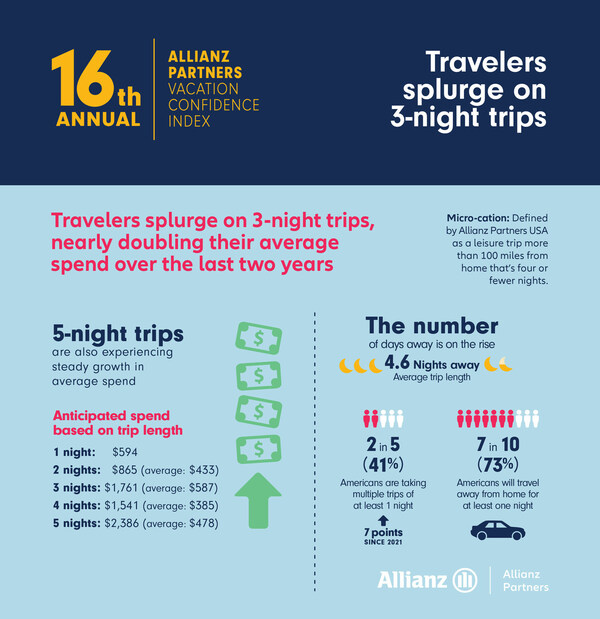Average Trip Length Expected to Grow to 4.6 Nights as the Amount Spent on 3-Night Trips Nearly Doubles Over Two Years
RICHMOND, Va., Aug. 8, 2024 — Americans are planning to take longer stretches of time off this summer, according to Allianz Partners USA‘s 16th Annual Vacation Confidence Index. New research indicates that travel remains a strong priority based on an increase in both average trip length and average spend on room nights, with staggering splurge statistics reported for three-night getaways.
As both travel and confidence have rebounded in recent years, the average number of nights spent away per trip has been steadily creeping up and now sits at 4.6 versus 4.5 (2023), 4.3 (2022), and 4.1 (2021) nights away. The “micro-cation” trend – previously coined by Allianz Partners USA and characterized as a leisure trip of four nights or fewer – is seemingly growing less popular as travelers opt to spend more nights away on vacation.
Between May and September, seven in ten (73%) Americans will travel away from home for at least one night, promising a busy summer travel season this year. Two in five of those surveyed (41%, up two points from 2023) also are planning ‘multi-cations,’ or multiple getaways at least 100 miles from home for at least a night – an increase over the years past (39% in 2022 and 34% in 2021) and an all-time high. This year’s findings spotlight the continued importance Americans are placing on travel, with 16% taking at least three trips away this summer.
Length of time spent away isn’t the only travel indicator that’s creeping up, according to the 16th Annual Vacation Confidence Index. With summer vacation spending expected to hit an all-time high of $221 billion in 2024, it comes as no surprise that average cost per night is also on the rise. Long weekends and summer Fridays have captivated the American traveler – those who are still opting for micro-cations and taking three-night vacations are more likely to splurge at a rate of $587 per night, a figure that has almost doubled since 2022.
Budget is of less concern for those jetting off for one night, and one night only, with trip spend averaging a similar $594. When tacking on a second night, travelers plan to spend $865 total, bringing the nightly cost down to $433. The best value is found for the popular four-night trip, with average spend dipping down to $385, as well as the 6-7 nights range, with travelers shelling out $406 and $401 per night, respectively.
“From cityscapes and mountainsides to coastlines and canyonlands, this summer promises a jam-packed travel season as Americans look to plan multiple trips at a growing average length. Whether splurging for a long weekend or finding added value on longer getaways, travelers are making the most of their time off this summer,” said Daniel Durazo, director of external communications at Allianz Partners USA. “Frequent trip planners, or those taking ‘multi-cations,’ may want to consider an annual travel insurance policy, which offers not only convenience and value, but also peace of mind in the form of trip protection that can last for an entire year.”
The Vacation Confidence Index has been conducted each summer since 2009 by national polling firm Ipsos Public Affairs on behalf of Allianz Partners USA. A vacation is defined as a leisure trip of at least one week to a place that is 100 miles or more from home.
Allianz Partners offers travel insurance through most major U.S. airlines, leading travel agents, online travel agencies, hotel companies, cruise lines and directly to consumers. For more information on Allianz Partners and available travel policies, please visit http://www.allianztravelinsurance.com/.
*Methodology: These are the findings of an Ipsos poll conducted on behalf of Allianz Partners. For this survey, a sample of 2,010 Americans aged 18+ was interviewed from April 15 to 22, 2024 via the Ipsos Online Omnibus. The precision of Ipsos online polls is measured using a credibility interval. In this case, the results are accurate to within +/- 2.5 percentage points, 19 times out of 20, of what the results would have been had all American adults been polled. Quota sampling and weighting were employed in order to balance demographics and ensure that the sample’s composition reflects that of the actual U.S. population, according to data from the U.S. Census Bureau. Credibility intervals are wider among subsets of the population.


